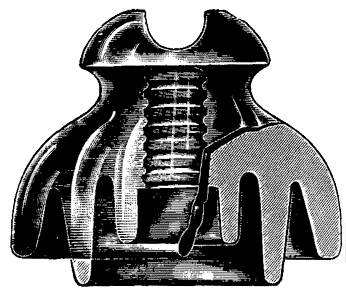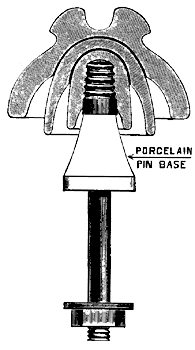[Trade Journal]
Publication: The Journal of Electricity
San Francisco, CA, United States
vol. V, no. 5, p. 107, col. 1-2
"LOCKE" HIGH POTENTIAL INSULATORS.
Much has been written and a great deal more has been said about the superiority of porcelain over glass in the manufacture of insulators for high potential circuits, on account of the knowledge that under ordinary conditions, glass was hygroscopic and more friable than porcelain. This was quite true of glass insulators, as ordinarily manufactured, and with a knowledge and clear understanding of these deficiencies Mr. Fred M. Locke of Victor, N. Y., undertook their remedy and as a result produced the insulator illustrated in this column. This insulator is very similar in general form to the familiar "Locke" No. 3, porcelain insulator, so largely used in California, but it is however considerably larger, being 5-1/2 inches in diameter. The great point of difference between this insulator and other glass insulators lies in the fact that the Locke insulator is made of a tough glass, which after manufacture is carefully annealed, the product being an insulator which is as tough as porcelain and which it is practically impossible to puncture. While a laboratory test may develop considerable difference in the hygroscopic properties of the two materials, it is not borne out in practice, since the deposit of dust and dirt on the outer petticoats of insulators on a line practically eliminates this consideration. These insulators are now all sold subject to a guarantee to withstand a test of 50,000 volts.
 |
These conditions, together with that of the actual cost, have resulted in the adoption of this insulator for all high voltage power transmission lines in California that have been built since it has been placed upon the market, and for electro-motive-forces as high as 20,000 volts. These insulators are to be used on the transmission line now being built over the Chilcoot Pass in Alaska, and also on the Goldstream-Victoria transmission line of the British Columbia Electric Railway Company; in this latter case the entire contract for line material having been placed with Mr. Locke.
There are still those who prefer porcelain insulators. In very moist climates they are no doubt preferable, and for this class of work the "Locke" three part china insulator has been developed.
 |
This insulator is made up of three glazed shells of vitrified china, glazed inside and out and then fused together to form a single insulator, as shown in the accompanying cut, being thoroughly vitrified before glazing. Should the glass be injured by impact or otherwise, by reason of its vitrification the insulator will not absorb moisture. These insulators recently withstood a dry test of 72,000 volts and a wet test of 54,000 volts, at which voltages the arcs followed around the petticoats. The test showing conclusively that porcelain insulators manufactured in this way are capable of withstanding the high voltages now in use on in contemplation.
The cut of this insulator here shown also illustrates the "Locke" steel pin with a porcelain base. The heavy copper wires used in transmitting large blocks of power have necessitated radical improvements in line construction and the old and familiar oak pin, one and a half inches in diameter has had to be discarded in many cases. Boring the cross arms for these large pins materially weakens them, and even where it is possible to increase the cross section of the arm, the wood pin itself is a source of weakness, not only on account of the strains introduced by the weight of the wire supported, but also on account of its liability to be burnt off by the static discharges between the insulators and pins. These difficulties have been met by the "Locke" pin, which is a steel pin with a wood top and a vitrified and glazed porcelain base, which extends from under the petticoat of the insulator to the cross arm. The steel pin is 7-16 in diameter, and only a 1/2-inch hole in the cross arm is necessary, and since the porcelain base receives all static discharges, no burning of the cross arm or pin is possible. This is not merely a theoretical condition, but is an actual one that has been demonstrated by experience in many cases.
These pins are to be used by the Southern California Power Company for their 33,000 volt transmission into Los Angeles; the San Joaquin Electric Company's 20,000 volt transmission to Hanford, Cal., and by the Yuba Power Company on their 16,500 volt transmission to Marysville, Cal.
Mr. Locke is represented on the Pacific Coast by Mr. Jno. Martin, 300 California Street, San Francisco, where samples may be seen.
